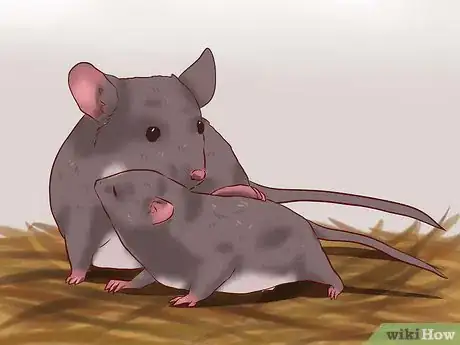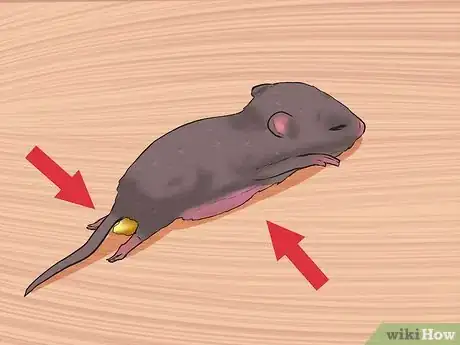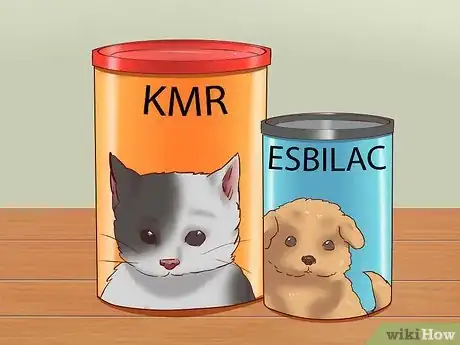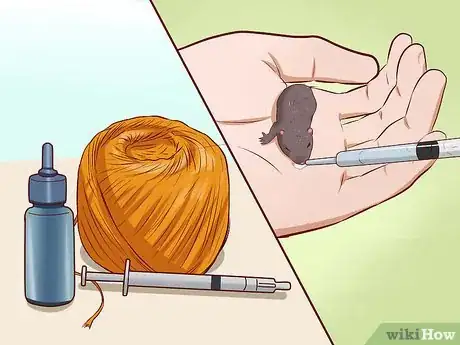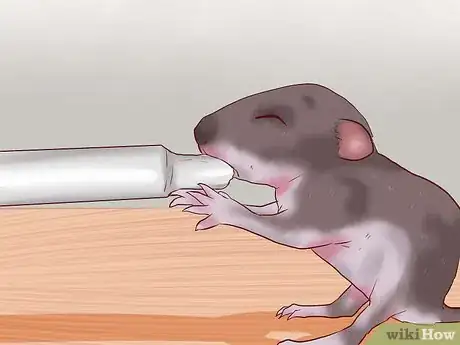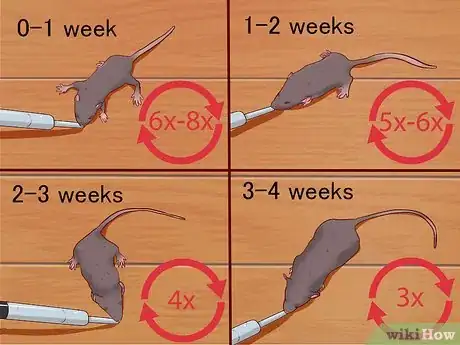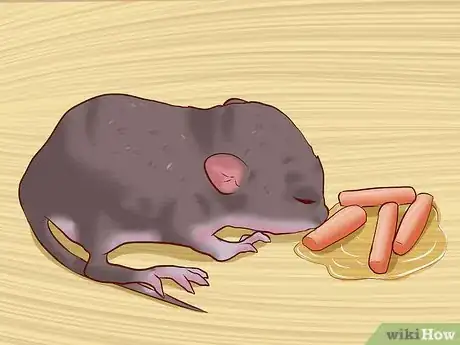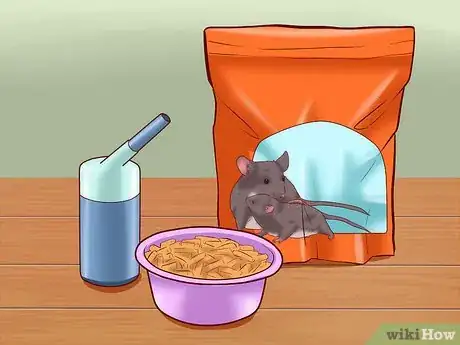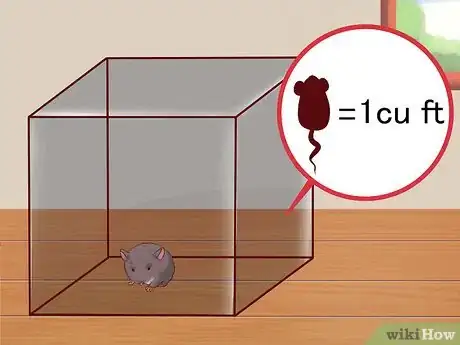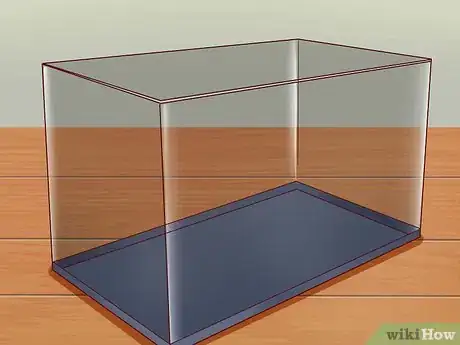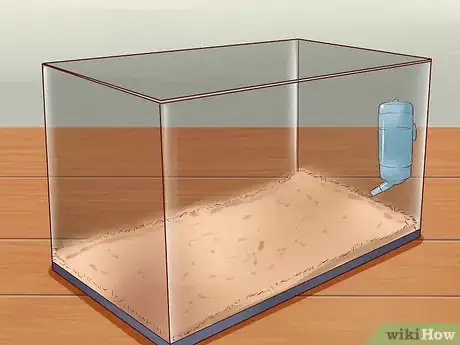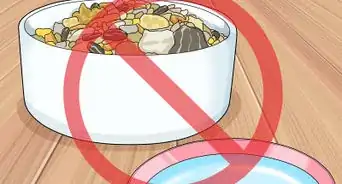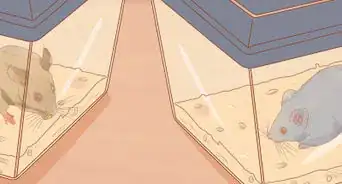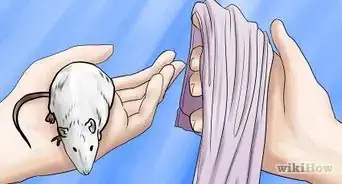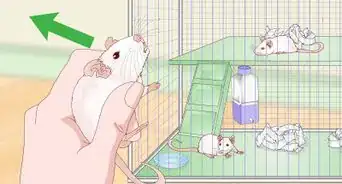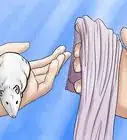This article was co-authored by Pippa Elliott, MRCVS. Dr. Elliott, BVMS, MRCVS is a veterinarian with over 30 years of experience in veterinary surgery and companion animal practice. She graduated from the University of Glasgow in 1987 with a degree in veterinary medicine and surgery. She has worked at the same animal clinic in her hometown for over 20 years.
There are 7 references cited in this article, which can be found at the bottom of the page.
wikiHow marks an article as reader-approved once it receives enough positive feedback. This article received 33 testimonials and 100% of readers who voted found it helpful, earning it our reader-approved status.
This article has been viewed 767,689 times.
Whether your adult mice had babies or you stumbled across abandoned baby mice, caring for these small, fragile infants can be a difficult task. Baby mice need to receive proper care within a few hours of being born in order to survive, so take immediate action if you find orphaned mice.[1]
Steps
Helping the Mother Care for Her Babies
-
1Watch the mother closely for signs of aggression or carelessness. If the babies you are caring for have a mother, she will likely keep them alive. However, female mice are often careless towards their young, may abandon a litter, and may even eat some of their offspring.
- If the mother stops feeding her young, or if she eats any babies, place her in a separate cage
- If the mother is aggressive or does not care for the infants, you will need to feed and care for them yourself.
-
2Find a foster mother if the mice are orphans. If you know where to find another nursing female, she may accept the orphaned baby mice as her own.[2] This is the best option, both psychologically and physically, for the babies but it is not always possible, especially if they are over 1.5 weeks old.
- Quickly find a nursing mother from a pet store or breeder.
- Rub the foster babies with bedding from the new mother’s cage to let them absorb her smells.
- Place the babies in the mother’s tank.
- Keep an eye out for signs of aggression, excessive squeaking, or abandonment.
Advertisement -
3Watch the babies for signs of diarrhea and dehydration. Even if a biological or surrogate mother is taking care of the newborn mice, diarrhea and dehydration are common problems you may encounter when raising newborn mice.[3] Dehydration occurs alongside diarrhea and can kill the babies if not treated.
- A swollen tummy, lethargy, and yellowish discharge from the anus are signs of diarrhea.[4]
- Replace the mother’s milk or formula with an electrolyte solution for human infants.
- Take the babies to a vet to ensure they are healthy.
Feeding Baby Mice
-
1Prepare formula to feed the mice. Your local pet store will carry many different formula options, such as Kitten Milk Replacer or Esbilac, that can be used to feed baby mice.[5] Human formulas Enfamil (the kind without iron) and Soyalac can also be used. Whole, raw goats milk will nourish the babies as well.
- Slightly warm the formula or milk before feeding; do not use hot or cold formula.
- Powdered formulas will need to be mixed with water per the directions on the container.
- The babies must be warm before feeding, or they won’t be able to digest the formula properly. If this happens, the formula will ferment in their bellies, causing diarrhea. You can keep the babies warm by placing a heating pad on a low setting underneath their enclosure.[6]
-
2Use a small syringe, small nursing bottle, or absorbent string for feeding. You can also use an eyedropper. If you are using a syringe or bottle, suck liquid up into the container to prepare for feeding. If you are using string, simply dip it into the formula until it is dripping.
-
3Place small drops of food into the mouth. Take care to not squeeze the syringe or bottle with much force. If you see liquid bubbling from their noses, stop feeding immediately.[7] When the mice have round, full tummies, they do not need any more food.
-
4Feed the mice frequently. Mice ages 0-1 week need feedings 6-8 times a day; mice 1-2 weeks need feedings 5-6 times a day; mice 2-3 weeks need feedings 4 times a day; and mice 4 weeks old only need feedings 3 times a day.[8] Space each feeding a couple of hours apart. You will also have to feed the mice during the night.
-
5Stimulate the babies after feeding so they use the bathroom.[9] Use a cotton ball or your finger, and gently brush over their private areas. A small amount of liquid will come out, but if the baby is dehydrated, nothing may come out. Rub until there is no more liquid.
-
6Wean the babies after 3 to 4 weeks.[10] For the first several days of weaning, provide a small amount of moistened rodent pellets for the weaning mice; drizzle water over the pellets to prepare them, then place them in an easily accessible area.
- Soon, the mice will be nibbling at the soaked crumbles.
- When the mice appear to be getting stronger, try feeding them regular rodent pellets.
-
7Provide healthy pellets and water once the babies are weaned. Pet supply stores have rodent chow available, whether it comes in blocks or pellets. Choose a formula that is 16% protein, 18% fiber, and less than 4% fat to raise healthy mice.[11]
- You no longer have to wet the pellets once the babies are weaned.
- You can provide apples, bananas, broccoli, and other snacks, but remember that mice have tiny stomachs and should not overeat.
- Mice usually drink 3-7 ml of water per day.[12] Hang a small animal water bottle in the cage, and keep it filled.
- Before weaning, the mice were getting water from their food. Once they begin to eat dry food, the water bottle is necessary.
Providing a Suitable Living Environment
-
1Provide a cage with at least 1 cubic foot (0.3 cubic meters) of space per mouse. This amount of space is necessary even if the babies are not fully grown. Your local pet store will have many cages to choose from, but be sure to buy one big enough.
-
2Choose a proper cage. Mouse cages should not provide spaces where the mice can escape and should have a solid floor (without wire grates). Plastic cages will often become damaged after cleaning, so opt instead for metal and glass cages or aquariums that can withstand thorough cleanings.
- Mice are very good at chewing, so choose a cage without protruding parts and wires the mice can chew on.
- Provide hiding spots for the mice, such as small boxes or cardboard tubes.
- Using a cardboard box for the babies is only a temporary option, as mice will quickly learn to chew through the box and escape.
-
3
-
4Keep the cage between 75°F (24°C) and 90°F (32°C). This will keep the babies warm and comfortable. Use your at-home heater and air conditioner to monitor the temperature.
Expert Q&A
-
QuestionCan I put baby mice under a heating lamp?
 Pippa Elliott, MRCVSDr. Elliott, BVMS, MRCVS is a veterinarian with over 30 years of experience in veterinary surgery and companion animal practice. She graduated from the University of Glasgow in 1987 with a degree in veterinary medicine and surgery. She has worked at the same animal clinic in her hometown for over 20 years.
Pippa Elliott, MRCVSDr. Elliott, BVMS, MRCVS is a veterinarian with over 30 years of experience in veterinary surgery and companion animal practice. She graduated from the University of Glasgow in 1987 with a degree in veterinary medicine and surgery. She has worked at the same animal clinic in her hometown for over 20 years.
Veterinarian You are absolutely right to think about keeping the baby mouse warm. Make a cozy nest from an old T-shirt. Using a heat source, such as a heat lamp, is ideal.
You are absolutely right to think about keeping the baby mouse warm. Make a cozy nest from an old T-shirt. Using a heat source, such as a heat lamp, is ideal. -
QuestionI found a baby mouse almost killed by my cats and its back legs aren't working. I tried feeding it cheese, but it's just shivering and staring at the cheese. What do I do?
 Pippa Elliott, MRCVSDr. Elliott, BVMS, MRCVS is a veterinarian with over 30 years of experience in veterinary surgery and companion animal practice. She graduated from the University of Glasgow in 1987 with a degree in veterinary medicine and surgery. She has worked at the same animal clinic in her hometown for over 20 years.
Pippa Elliott, MRCVSDr. Elliott, BVMS, MRCVS is a veterinarian with over 30 years of experience in veterinary surgery and companion animal practice. She graduated from the University of Glasgow in 1987 with a degree in veterinary medicine and surgery. She has worked at the same animal clinic in her hometown for over 20 years.
Veterinarian Keep the baby mouse warm and in a quiet, dark box. If however they are still not using their back legs after an hour or so, then euthanasia is the humane options.
Keep the baby mouse warm and in a quiet, dark box. If however they are still not using their back legs after an hour or so, then euthanasia is the humane options.
Warnings
- Don't ever hold your mouse by its tail.⧼thumbs_response⧽
- Make sure that your cat or dog doesn't eat the baby mice.⧼thumbs_response⧽
Things You'll Need
- Formula
- Alarm Clock
- Electric Heater Pad
- Clean Bowl
- Small Jar
- Soft Fine Paint Brush
- Q-Tips/Cotton Swabs
- Electrolytes (For Babies)
- Tank
- Toilet Paper
- Soft Wash Cloth
- Soft Paper Towel
- Date Blocks
- Whole Goats Milk/ Homemade Formula
- Clean Towel
- Kitten formula (mixed with twice the amount of distilled water)
- Distilled Water
References
- ↑ http://mouseranch.com/FYI/orphans.shtml
- ↑ http://www.afrma.org/orphanrm.htm
- ↑ http://www.afrma.org/orphanrm.htm
- ↑ http://animals.mom.me/mouse-rotavirus-1291.html
- ↑ http://www.afrma.org/orphanrm.htm
- ↑ http://www.afrma.org/orphanrm.htm
- ↑ http://www.afrma.org/orphanrm.htm
- ↑ http://www.rmca.org/Articles/orphans.htm
- ↑ http://www.rmca.org/Articles/orphans.htm
- ↑ http://ko.cwru.edu/info/musfrming.html
- ↑ https://www.aspca.org/pet-care/small-pet-care/mouse-care
- ↑ http://www.spcacanterbury.org.nz/animal-care/caring-for-your-pets/mice/
- ↑ https://www.aspca.org/pet-care/small-pet-care/mouse-care
- ↑ http://www.spcacanterbury.org.nz/animal-care/caring-for-your-pets/mice/
About This Article
If you’re caring for baby mice that have lost their mother, you’ll need to feed them some kind of formula, such as human baby formula, kitten formula, or raw goat milk. Warm the formula slightly before feeding it to the mice. Use an eyedropper or syringe to feed the babies 1 small drop at a time until their bellies are nice and round. For the first week of life, baby mice need to eat 6 to 8 times a day. Each week, reduce the number of feedings slightly until they are eating 3 times a day at 4 weeks. After feeding the mice, use a cotton swab or your finger to lightly massage their private parts and encourage them to pee and poop. At 3-4 weeks, start offering them moistened rodent pellets to start the weaning process. Keep your baby mice in a cage with a solid bottom lined with clean, rodent-safe bedding. Place it in a warm room and keep the temperature between 75-90° F (24-32° C). Keep reading to learn how to wean mice off of milk!
